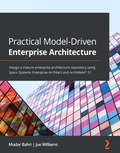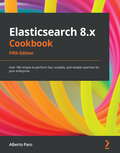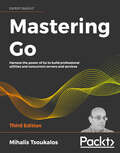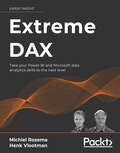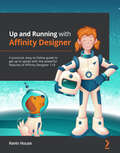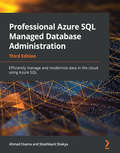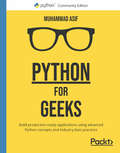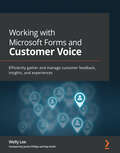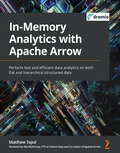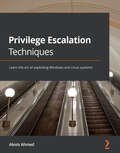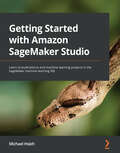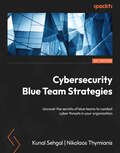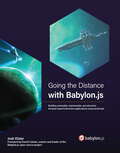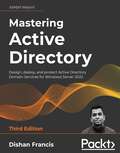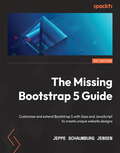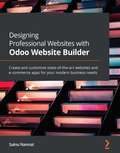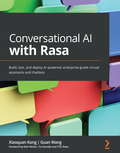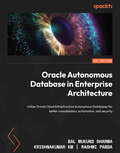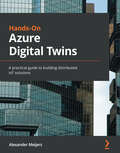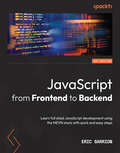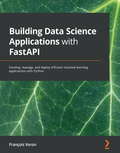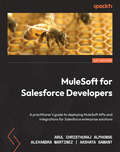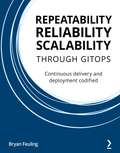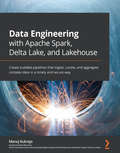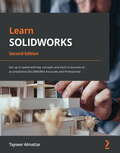- Table View
- List View
Practical Model-Driven Enterprise Architecture: Design a mature enterprise architecture repository using Sparx Systems Enterprise Architect and ArchiMate® 3.1
by Mudar Bahri Joe WilliamsBridge the gap between theory and reality by implementing real-world examples using the Sparx EA tool and ArchiMate® 3.1 specification to develop sophisticated enterprise architecture models serving every unit in your organizationKey FeaturesDiscover the various artifacts that enterprise architects need to develop for stakeholders to make sound decisionsBuild a functional enterprise architecture repository that is rich in information, references, and metamodelsLearn how to use Sparx Enterprise Architect from scratchBook DescriptionMost organizations face challenges in defining and achieving evolved enterprise architecture practices, which can be a very lengthy process even if implemented correctly. Developers, for example, can build better solutions only if they receive the necessary design information from architects, and decision-makers can make appropriate changes within the organization only if they know the implications of doing so.The book starts by addressing the problems faced by enterprise architecture practitioners and provides solutions based on an agile approach to enterprise architecture, using ArchiMate® 3.1 as an industry standard and Sparx EA as the modeling tool. You'll learn with the help of a fictional organization that has three business units, each expecting something different from you as the enterprise architect. You'll build the practice, satisfy the different requirements of each business unit, and share the knowledge with others so they can follow your steps. Toward the end, you'll learn how to put the diagrams and the content that you have developed into documents, presentations, and web pages that can be published and shared with any stakeholder.By the end of this book, you'll be able to build a functional enterprise architecture practice that supports every part of your organization. You'll also have developed the necessary skills to populate your enterprise architecture repository with references and artifacts.What you will learnDiscover how enterprise architects can contribute to projects and departments within organizationsUse Sparx Enterprise Architect to build a rich architecture repositoryLearn about the ArchiMate® 3.1 specification as you apply it in real-world projectsUse the focused metamodel technique to build the information necessary for maintaining your repository's consistency and accuracyUnderstand the importance of keeping architectural artifacts simple yet eye-catchingDefine an operational model that fits your initial needs and expands as requiredWho this book is forThis book is for enterprise architects at all architectural layers and practices of any maturity level. Many of the artifacts suggested in this book are inspired by The Open Group Architecture Framework (TOGAF®); however, familiarity with TOGAF® is not required. Whether you work within the business, applications, data, or technology layers, this book covers examples that apply to your work. Although not mandatory, experience modeling in Sparx Systems Enterprise Architect using any modeling language will be helpful. No prior knowledge of ArchiMate® is required to get started with this book.
Elasticsearch 8.x Cookbook: Over 180 recipes to perform fast, scalable, and reliable searches for your enterprise, 5th Edition
by Alberto ParoSearch, analyze, store and manage data effectively with Elasticsearch 8.xKey FeaturesExplore the capabilities of Elasticsearch 8.x with easy-to-follow recipesExtend the Elasticsearch functionalities and learn how to deploy on Elastic CloudDeploy and manage simple Elasticsearch nodes as well as complex cluster topologiesBook DescriptionElasticsearch is a Lucene-based distributed search engine at the heart of the Elastic Stack that allows you to index and search unstructured content with petabytes of data. With this updated fifth edition, you'll cover comprehensive recipes relating to what's new in Elasticsearch 8.x and see how to create and run complex queries and analytics. The recipes will guide you through performing index mapping, aggregation, working with queries, and scripting using Elasticsearch. You'll focus on numerous solutions and quick techniques for performing both common and uncommon tasks such as deploying Elasticsearch nodes, using the ingest module, working with X-Pack, and creating different visualizations. As you advance, you'll learn how to manage various clusters, restore data, and install Kibana to monitor a cluster and extend it using a variety of plugins. Furthermore, you'll understand how to integrate your Java, Scala, Python, and big data applications such as Apache Spark and Pig with Elasticsearch and create efficient data applications powered by enhanced functionalities and custom plugins. By the end of this Elasticsearch cookbook, you'll have gained in-depth knowledge of implementing the Elasticsearch architecture and be able to manage, search, and store data efficiently and effectively using Elasticsearch.What you will learnBecome well-versed with the capabilities of X-PackOptimize search results by executing analytics aggregationsGet to grips with using text and numeric queries as well as relationship and geo queriesInstall Kibana to monitor clusters and extend it for pluginsBuild complex queries by managing indices and documentsMonitor the performance of your cluster and nodesDesign advanced mapping to take full control of index stepsIntegrate Elasticsearch in Java, Scala, Python, and big data applicationsWho this book is forIf you're a software engineer, big data infrastructure engineer, or Elasticsearch developer, you'll find this Elasticsearch book useful. The book will also help data professionals working in e-commerce and FMCG industries who use Elastic for metrics evaluation and search analytics to gain deeper insights and make better business decisions. Prior experience with Elasticsearch will help you get the most out of this book.
Mastering Go: Harness the power of Go to build professional utilities and concurrent servers and services, 3rd Edition
by Mihalis TsoukalosMaster key features of Go, including advanced concepts like concurrency and working with JSON, to create and optimize real-world services, network servers, and clientsKey FeaturesThird edition of the bestselling guide to advanced Go programming, expanded to cover RESTful servers, the WebSocket protocol, and Go genericsUse real-world exercises to build high-performance network servers and powerful command line utilitiesPacked with practical examples and utilities to apply to your own development work and administrative tasksClearly explains Go nuances and features to simplify Go developmentBook DescriptionGo is the language of the future for high-performance systems due to its simplicity and clear principles. Mastering Go shows you how to put Go to work on real production systems. This new edition has been updated to include topics like creating RESTful servers and clients, understanding Go generics, and developing gRPC servers and clients. Mastering Go, Third Edition explores the capabilities of Go in practice. You will become confident with advanced concepts, including concurrency and the operation of the Go Garbage Collector, using Go with Docker, writing powerful command-line utilities, working with JavaScript Object Notation (JSON) data, and interacting with databases. You will also improve your understanding of Go internals to optimize Go code and use data types and data structures in new and unexpected ways. This Go programming book also covers the nuances and idioms of Go with exercises and resources to fully embed your newly acquired knowledge. Become an expert Go programmer by building Go systems and implementing advanced Go techniques in your projects.What you will learnUse Go in productionWrite reliable, high-performance concurrent codeManipulate data structures including slices, arrays, maps, and pointersDevelop reusable packages with reflection and interfacesBecome familiar with generics for effective Go programmingCreate concurrent RESTful servers, and build gRPC clients and serversDefine Go structures for working with JSON dataWho this book is forThis book is for Go programmers with previous coding experience, who are familiar with the basics of the language and want to become expert Go practitioners.
Extreme DAX: Take your Power BI and Microsoft data analytics skills to the next level
by Michiel Rozema Henk VlootmanDiscover the true power of DAX and build advanced DAX solutions for practical business scenariosKey FeaturesSolve complex business problems within Microsoft BI tools including Power BI, SQL Server, and ExcelDevelop a conceptual understanding of critical business data modeling principlesLearn the subtleties of Power BI data visualizations, evaluation context, context transition, and filteringBook DescriptionIf you want to get the most out of Microsoft Business Intelligence tools, sooner or later you'll need to master DAX. Extreme DAX enables business analysts to generate powerful and sophisticated analyses from their data.You'll learn the principles of business intelligence, good model design, and how DAX fits into it all. Then, you'll launch into detailed examples of DAX in real-world business scenarios such as inventory calculations, forecasting, intercompany business, and data security. At each step, senior DAX experts will walk you through the subtleties involved in working with Power BI models and common mistakes to look out for as you build advanced data aggregations.You'll deepen your understanding of DAX functions, filters, and measures, and how and when they can be used to derive effective insights. Also provided with the book are PBIX files for each chapter for you to follow along with and explore in your own time.What you will learnUnderstand data modeling concepts and structures before you start working with DAXGrasp how relationships in Power BI models are different from those in RDBMSesSecure aggregation levels, attributes, and hierarchies using PATH functions and row-level securityGet to grips with the crucial concept of contextApply advanced context and filtering functions including TREATAS, GENERATE, and SUMMARIZEExplore dynamically changing visualizations with helper tables and dynamic labels and axesWork with week-based calendars and understand standard time-intelligenceEvaluate investments intelligently with the XNPV and XIRR financial DAX functionsWho this book is forIf you are an analyst with a working knowledge of DAX in MS Power BI or other Microsoft analytics tools, this book will help you upgrade your DAX knowledge and work with analytical models more effectively.This book is not for beginners and practical experience with DAX is necessary.
Up and Running with Affinity Designer: A practical, easy-to-follow guide to getting up to speed with Affinity Designer
by Kevin HouseAdd Affinity Designer to your creative skillset while creating innovative designs and illustrations, building a solid foundation for your futureKey FeaturesUnderstand Affinity Designer's interface and setup, discover its capabilities, and develop an efficient workflowHarness the power of an easy and flexible vector and pixel workflow in one applicationLearn practical skills and gain the confidence to power your own creative projectsBook DescriptionAffinity Designer is a relatively new creative application and, in a reasonably short time, it has quickly become a powerhouse design and illustration application. Affinity Designer, along with Affinity Photo and Affinity Publisher, is part of a suite of award-winning creative software applications developed by Serif Europe. Built on the latest technologies, which make it fast and smooth, Affinity Designer is quickly becoming the go-to professional creative application for vector drawing and pixel-based painting.Up and Running with Affinity Designer is a comprehensive hands-on introduction to the Affinity Designer software. Whether you're new to the creative industry, a seasoned professional looking for a proven alternative, or an enthusiastic hobbyist, this book will help you get up to speed in no time. Complete with straightforward explanations and supporting hands-on exercises, this easy-to-follow guide will help you gain a solid foundation in Affinity Designer and form a base for in-depth exploration in your own projects.By the end of this Affinity Designer book, you'll have gained the knowledge and confidence to use Affinity Designer as part of your creative toolset.What you will learnExplore the interface and unique UX characteristics of Affinity DesignerDiscover features that allow you to manipulate and transform objectsApply color, shading, and effects to create unique compositionsEmploy layers to organize and simplify complex projectsUse grids, guides, and snapping features as design aidsAdapt to Affinity Designer's custom workspaces and keyboard shortcutsExplore the workflow and design best practices for more predictable and successful outcomesIdentify potential stumbling blocks in your design process and learn how to avoid themWho this book is forThis Affinity Designer book is for graphic designers, artists, illustrators, and hobbyists. Anyone curious about Affinity Designer's unique toolset and vector and pixel workflows or looking for cost-effective alternatives to the Adobe suite will find this book useful. Experience in working with other similar tools will be helpful, but not necessary.
Professional Azure SQL Managed Database Administration: Efficiently manage and modernize data in the cloud using Azure SQL, 3rd Edition
by Ahmad Osama Shashikant ShakyaMaster data management by effectively utilizing the features of Azure SQL database.Key FeaturesLearn to automate common management tasks with PowerShell.Understand different methods to generate elastic pools and shards to scale Azure SQL databases.Learn to develop a scalable cloud solution through over 40 practical activities and exercises.Book DescriptionDespite being the cloud version of SQL Server, Azure SQL Database and Azure SQL Managed Instance stands out in various aspects when it comes to management, maintenance, and administration. Updated with the latest Azure features, Professional Azure SQL Managed Database Administration continues to be a comprehensive guide for becoming proficient in data management. The book begins by introducing you to the Azure SQL managed databases (Azure SQL Database and Azure SQL Managed Instance), explaining their architecture, and how they differ from an on-premises SQL server. You will then learn how to perform common tasks, such as migrating, backing up, and restoring a SQL Server database to an Azure database. As you progress, you will study how you can save costs and manage and scale multiple SQL databases using elastic pools. You will also implement a disaster recovery solution using standard and active geo-replication. Finally, you will explore the monitoring and tuning of databases, the key features of databases, and the phenomenon of app modernization. By the end of this book, you will have mastered the key aspects of an Azure SQL database and Azure SQL managed instance, including migration, backup restorations, performance optimization, high availability, and disaster recovery.What you will learnUnderstanding Azure SQL database configuration and pricing optionsProvisioning a new SQL database or migrating an existing on-premises SQL Server database to an Azure SQL databaseBacking up and restoring an Azure SQL databaseSecuring and scaling an Azure SQL databaseMonitoring and tuning an Azure SQL databaseImplementing high availability and disaster recovery with an Azure SQL databaseManaging, maintaining, and securing managed instancesWho this book is forThis book is designed to benefit database administrators, database developers, or application developers who are interested in developing new applications or migrating existing ones with Azure SQL database.Prior experience of working with an on-premise SQL Server or Azure SQL database along with a basic understanding of PowerShell scripts and C# code is necessary to grasp the concepts covered in this book.
Python for Geeks: Build production-ready applications using advanced Python concepts and industry best practices
by Muhammad AsifTake your Python skills to the next level to develop scalable, real-world applications for local as well as cloud deploymentKey FeaturesAll code examples have been tested with Python 3.7 and Python 3.8 and are expected to work with any future 3.x releaseLearn how to build modular and object-oriented applications in PythonDiscover how to use advanced Python techniques for the cloud and clustersBook DescriptionPython is a multipurpose language that can be used for multiple use cases. Python for Geeks will teach you how to advance in your career with the help of expert tips and tricks.You'll start by exploring the different ways of using Python optimally, both from the design and implementation point of view. Next, you'll understand the life cycle of a large-scale Python project. As you advance, you'll focus on different ways of creating an elegant design by modularizing a Python project and learn best practices and design patterns for using Python. You'll also discover how to scale out Python beyond a single thread and how to implement multiprocessing and multithreading in Python. In addition to this, you'll understand how you can not only use Python to deploy on a single machine but also use clusters in private as well as in public cloud computing environments. You'll then explore data processing techniques, focus on reusable, scalable data pipelines, and learn how to use these advanced techniques for network automation, serverless functions, and machine learning. Finally, you'll focus on strategizing web development design using the techniques and best practices covered in the book.By the end of this Python book, you'll be able to do some serious Python programming for large-scale complex projects.What you will learnUnderstand how to design and manage complex Python projectsStrategize test-driven development (TDD) in PythonExplore multithreading and multiprogramming in PythonUse Python for data processing with Apache Spark and Google Cloud Platform (GCP)Deploy serverless programs on public clouds such as GCPUse Python to build web applications and application programming interfacesApply Python for network automation and serverless functionsGet to grips with Python for data analysis and machine learningWho this book is forThis book is for intermediate-level Python developers in any field who are looking to build their skills to develop and manage large-scale complex projects. Developers who want to create reusable modules and Python libraries and cloud developers building applications for cloud deployment will also find this book useful. Prior experience with Python will help you get the most out of this book.
Working with Microsoft Forms and Customer Voice: Efficiently gather and manage customer feedback, insights, and experiences
by Welly Lee James Phillips Ray SmithWork with business scenarios and discover best practices to get the most out of Microsoft Forms and Microsoft Dynamics 365 Customer VoiceKey FeaturesExplore step-by-step instructions to integrate surveys with Microsoft 365 appsAutomate surveys and follow-up actions from survey results using Microsoft FormsCreate custom report dashboards and explore advanced analytics for managing insightsBook DescriptionMicrosoft Forms and Dynamics 365 Customer Voice enable organizations to collect and analyze feedback from employees and customers, helping developers to integrate their feedback and business users to collect feedback that will guide them to develop customer-centric solutions. This book takes a hands-on approach to leveraging Microsoft Forms and Dynamics 365 Customer Voice capabilities for common feedback scenarios and covers best practices and tips and tricks to have your solution up and running in no time. You'll start by exploring common scenarios where organizations collect feedback from employees and customers and implement end-to-end solutions with Forms. You'll then discover how to create surveys and get to grips with different configuration options commonly used for each scenario. Throughout the book, you'll also find sample questions and step-by-step instructions for integrating the survey with related technology such as Microsoft Teams, Power Automate, and Power BI for an end-to-end scenario. By the end of this Microsoft book, you'll be able to build and deploy your complete solution using Microsoft Forms and Dynamics 365 Customer Voice, allowing you to listen to customers or employees, interpret their feedback, take timely follow-up action, and monitor results.What you will learnGet up and running with Microsoft Forms and Dynamics 365 Customer Voice servicesExplore common feedback scenarios and survey best practices Understand how to administer Microsoft Forms and Dynamics 365 Customer VoiceUse Microsoft Forms or Dynamics 365 Customer Voice to monitor your survey resultsSet up the Microsoft Forms app for Teams for conducting live pollsAutomate feedback collection and follow-up actionsWho this book is forThis book is for business users who want to increase customer and employee engagement and collect data for measuring user satisfaction and driving product and process improvements. Beginner-level knowledge of Microsoft products such as Office 365 (including Teams, Outlook, and Excel) is expected. The book also includes advanced topics for citizen developers to automate sending Customer Voice surveys, follow-up actions, and creating custom dashboards using Microsoft Power Platform applications like Power Automate and Power BI.
In-Memory Analytics with Apache Arrow: Perform fast and efficient data analytics on both flat and hierarchical structured data
by Matthew Topol Wes McKinneyProcess tabular data and build high-performance query engines on modern CPUs and GPUs using Apache Arrow, a standardized language-independent memory format, for optimal performanceKey FeaturesLearn about Apache Arrow's data types and interoperability with pandas and ParquetWork with Apache Arrow Flight RPC, Compute, and Dataset APIs to produce and consume tabular dataReviewed, contributed, and supported by Dremio, the co-creator of Apache ArrowBook DescriptionApache Arrow is designed to accelerate analytics and allow the exchange of data across big data systems easily.In-Memory Analytics with Apache Arrow begins with a quick overview of the Apache Arrow format, before moving on to helping you to understand Arrow's versatility and benefits as you walk through a variety of real-world use cases. You'll cover key tasks such as enhancing data science workflows with Arrow, using Arrow and Apache Parquet with Apache Spark and Jupyter for better performance and hassle-free data translation, as well as working with Perspective, an open source interactive graphical and tabular analysis tool for browsers. As you advance, you'll explore the different data interchange and storage formats and become well-versed with the relationships between Arrow, Parquet, Feather, Protobuf, Flatbuffers, JSON, and CSV. In addition to understanding the basic structure of the Arrow Flight and Flight SQL protocols, you'll learn about Dremio's usage of Apache Arrow to enhance SQL analytics and discover how Arrow can be used in web-based browser apps. Finally, you'll get to grips with the upcoming features of Arrow to help you stay ahead of the curve.By the end of this book, you will have all the building blocks to create useful, efficient, and powerful analytical services and utilities with Apache Arrow.What you will learnUse Apache Arrow libraries to access data files both locally and in the cloudUnderstand the zero-copy elements of the Apache Arrow formatImprove read performance by memory-mapping files with Apache ArrowProduce or consume Apache Arrow data efficiently using a C APIUse the Apache Arrow Compute APIs to perform complex operationsCreate Arrow Flight servers and clients for transferring data quicklyBuild the Arrow libraries locally and contribute back to the communityWho this book is forThis book is for developers, data analysts, and data scientists looking to explore the capabilities of Apache Arrow from the ground up. This book will also be useful for any engineers who are working on building utilities for data analytics and query engines, or otherwise working with tabular data, regardless of the programming language. Some familiarity with basic concepts of data analysis will help you to get the most out of this book but isn't required. Code examples are provided in the C++, Go, and Python programming languages.
Privilege Escalation Techniques: Learn the art of exploiting Windows and Linux systems
by Alexis AhmedEnumerate and exploit Linux or Windows systems and escalate your privileges to the highest levelKey FeaturesDiscover a range of techniques to escalate privileges on Windows and Linux systemsUnderstand the key differences between Windows and Linux privilege escalationExplore unique exploitation challenges in each chapter provided in the form of pre-built VMsBook DescriptionPrivilege escalation is a crucial step in the exploitation life cycle of a penetration tester. It helps penetration testers to set up persistence and facilitates lateral movement. This book is one of a kind, covering a range of privilege escalation techniques and tools for both Windows and Linux systems. The book uses virtual environments that you can download to test and run tools and techniques. Each chapter will feature an exploitation challenge in the form of pre-built virtual machines (VMs). As you progress, you will learn how to enumerate and exploit a target Linux or Windows system. This privilege escalation book then demonstrates how you can escalate your privileges to the highest level. By the end of this book, you will have gained the skills you need to be able to perform local kernel exploits, escalate privileges through vulnerabilities in services, maintain persistence, and enumerate information from the target such as passwords and password hashes.What you will learnUnderstand the privilege escalation process and set up a pentesting labGain an initial foothold on the systemPerform local enumeration on target systemsExploit kernel vulnerabilities on Windows and Linux systemsPerform privilege escalation through password looting and finding stored credentialsGet to grips with performing impersonation attacksExploit Windows services such as the secondary logon handle service to escalate Windows privilegesEscalate Linux privileges by exploiting scheduled tasks and SUID binariesWho this book is forThis Windows and Linux privilege escalation book is for intermediate-level cybersecurity students and pentesters who are interested in learning how to perform various privilege escalation techniques on Windows and Linux systems, which includes exploiting bugs, design flaws, and more. An intermediate-level understanding of Windows and Linux systems along with fundamental cybersecurity knowledge is expected.
Getting Started with Amazon SageMaker Studio: Learn to build end-to-end machine learning projects in the SageMaker machine learning IDE
by Michael HsiehBuild production-grade machine learning models with Amazon SageMaker Studio, the first integrated development environment in the cloud, using real-life machine learning examples and codeKey FeaturesUnderstand the ML lifecycle in the cloud and its development on Amazon SageMaker StudioLearn to apply SageMaker features in SageMaker Studio for ML use casesScale and operationalize the ML lifecycle effectively using SageMaker StudioBook DescriptionAmazon SageMaker Studio is the first integrated development environment (IDE) for machine learning (ML) and is designed to integrate ML workflows: data preparation, feature engineering, statistical bias detection, automated machine learning (AutoML), training, hosting, ML explainability, monitoring, and MLOps in one environment. In this book, you'll start by exploring the features available in Amazon SageMaker Studio to analyze data, develop ML models, and productionize models to meet your goals. As you progress, you will learn how these features work together to address common challenges when building ML models in production. After that, you'll understand how to effectively scale and operationalize the ML life cycle using SageMaker Studio. By the end of this book, you'll have learned ML best practices regarding Amazon SageMaker Studio, as well as being able to improve productivity in the ML development life cycle and build and deploy models easily for your ML use cases.What you will learnExplore the ML development life cycle in the cloudUnderstand SageMaker Studio features and the user interfaceBuild a dataset with clicks and host a feature store for MLTrain ML models with ease and scaleCreate ML models and solutions with little codeHost ML models in the cloud with optimal cloud resourcesEnsure optimal model performance with model monitoringApply governance and operational excellence to ML projectsWho this book is forThis book is for data scientists and machine learning engineers who are looking to become well-versed with Amazon SageMaker Studio and gain hands-on machine learning experience to handle every step in the ML lifecycle, including building data as well as training and hosting models. Although basic knowledge of machine learning and data science is necessary, no previous knowledge of SageMaker Studio and cloud experience is required.
Cybersecurity Blue Team Strategies: Uncover the secrets of blue teams to combat cyber threats in your organization
by Kunal Sehgal Nikolaos ThymianisBuild a blue team for efficient cyber threat management in your organizationKey FeaturesExplore blue team operations and understand how to detect, prevent, and respond to threatsDive deep into the intricacies of risk assessment and threat managementLearn about governance, compliance, regulations, and other best practices for blue team implementationBook DescriptionWe've reached a point where all organizational data is connected through some network. With advancements and connectivity comes ever-evolving cyber threats - compromising sensitive data and access to vulnerable systems. Cybersecurity Blue Team Strategies is a comprehensive guide that will help you extend your cybersecurity knowledge and teach you to implement blue teams in your organization from scratch. Through the course of this book, you'll learn defensive cybersecurity measures while thinking from an attacker's perspective. With this book, you'll be able to test and assess the effectiveness of your organization's cybersecurity posture. No matter the medium your organization has chosen- cloud, on-premises, or hybrid, this book will provide an in-depth understanding of how cyber attackers can penetrate your systems and gain access to sensitive information. Beginning with a brief overview of the importance of a blue team, you'll learn important techniques and best practices a cybersecurity operator or a blue team practitioner should be aware of. By understanding tools, processes, and operations, you'll be equipped with evolving solutions and strategies to overcome cybersecurity challenges and successfully manage cyber threats to avoid adversaries. By the end of this book, you'll have enough exposure to blue team operations and be able to successfully set up a blue team in your organization.What you will learnUnderstand blue team operations and its role in safeguarding businessesExplore everyday blue team functions and tools used by themBecome acquainted with risk assessment and management from a blue team perspectiveDiscover the making of effective defense strategies and their operationsFind out what makes a good governance programBecome familiar with preventive and detective controls for minimizing riskWho this book is forThis book is for cybersecurity professionals involved in defending an organization's systems and assets against attacks. Penetration testers, cybersecurity analysts, security leaders, security strategists, and blue team members will find this book helpful. Chief Information Security Officers (CISOs) looking at securing their organizations from adversaries will also benefit from this book. To get the most out of this book, basic knowledge of IT security is recommended.
Going the Distance with Babylon.js: Building extensible, maintainable, and attractive browser-based interactive applications using JavaScript
by David Catuhe Josh ElsterLearn to effortlessly leverage the power of the GPU in a 3D game or application using Babylon.js v5.0 from start to finishKey FeaturesExplore browser-based, editable, interactive Playground samplesCreate GPU-based resources using the Node Material Editor – no shader code requiredExtended topics in each chapter as well as a dedicated chapter that helps you explore and contribute back to OSS projectsBook DescriptionBabylon.js allows anyone to effortlessly create and render 3D content in a web browser using the power of WebGL and JavaScript. 3D games and apps accessible via the web open numerous opportunities for both entertainment and profit. Developers working with Babylon.js will be able to put their knowledge to work with this guide to building a fully featured 3D game.The book provides a hands-on approach to implementation and associated methodologies that will have you up and running, and productive in no time. Complete with step-by-step explanations of essential concepts, practical examples, and links to fully working self-contained code snippets, you'll start by learning about Babylon.js and the finished Space-Truckers game. You'll also explore the development workflows involved in making the game. Focusing on a wide range of features in Babylon.js, you'll iteratively add pieces of functionality and assets to the application being built. Once you've built out the basic game mechanics, you'll learn how to bring the Space-Truckers environment to life with cut scenes, particle systems, animations, shadows, PBR materials, and more.By the end of this book, you'll have learned how to structure your code, organize your workflow processes, and continuously deploy to a static website/PWA a game limited only by bandwidth and your imagination.What you will learnUse Babylon.js v5.0 to build an extensible open-source 3D game accessible with a web browserDesign and integrate compelling and performant 3D interactive scenes with a web-based applicationWrite WebGL/WebGPU shader code using the Node Material EditorSeparate code concerns to make the best use of the available resourcesUse the Babylon.js Playground to tightly iterate application implementationConvert a web application into a Progressive Web Application (PWA)Create rich, native-ready graphical user interfaces (GUIs) using the GUI EditorWho this book is forThis book on 3D programming in JavaScript is for those who have some familiarity with JavaScript programming and/or 3D game engine development and are looking to learn how to incorporate beautiful interactive 3D scenes into their work. Developers familiar with Unity, Unreal Engine, or three.js will also find this book to be a key resource for learning the ins and outs of Babylon.js.
Mastering Active Directory: Design, deploy, and protect Active Directory Domain Services for Windows Server 2022, 3rd Edition
by Dishan FrancisBecome an expert at managing enterprise identity infrastructure with Active Directory Domain Services 2022.Purchase of the print or Kindle book includes a free eBook in the PDF format.Key FeaturesDesign and update your identity infrastructure by utilizing the latest Active Directory features and core capabilitiesOvercome migration challenges as you update to Active Directory Domain Services 2022Establish a strong identity foundation in the cloud by consolidating secure accessBook DescriptionMastering Active Directory, Third Edition is a comprehensive guide for Information Technology professionals looking to improve their knowledge about MS Windows Active Directory Domain Service. The book will help you to use identity elements effectively and manage your organization's infrastructure in a secure and efficient way. This third edition has been fully updated to reflect the importance of cloud-based strong authentication and other tactics to protect identity infrastructure from emerging security threats. Mastering Active Directory, Third Edition provides extensive coverage of AD Domain Services and helps you explore their capabilities as you update to Windows Server 2022. This book will also teach you how to extend on-premises identity presence to cloud via Azure AD hybrid setup. By the end of this Microsoft Active Directory book, you'll feel confident in your ability to design, plan, deploy, protect, and troubleshoot your enterprise identity infrastructure.What you will learnInstall, protect, and manage Active Directory Domain Services (Windows Server 2022)Design your hybrid identity by evaluating business and technology requirementsAutomate administrative tasks in Active Directory using Windows PowerShell 7.xProtect sensitive data in a hybrid environment using Azure Information ProtectionLearn about Flexible Single Master Operation (FSMO) roles and their placementManage directory objects effectively using administrative tools and PowerShellCentrally maintain the state of user and computer configuration by using Group PoliciesHarden your Active Directory using security best practicesWho this book is forIf you are an Active Directory administrator, system administrator, or IT professional who has basic knowledge of Active Directory and is looking to become an expert in this topic, this book is for you.You need to have some experience of working with Active Directory to make the most of this book.
The Missing Bootstrap 5 Guide: Customize and extend Bootstrap 5 with Sass and JavaScript to create unique website designs
by Jeppe Schaumburg JensenMake your website stand out by unlocking the full potential of Bootstrap 5 and creating efficient UIsKey FeaturesFind out how to customize all parts of Bootstrap 5 with Sass, including working with the utility APICreate a unique website using only Bootstrap 5 with Sass customization and interactive featuresGrasp advanced Bootstrap 5 topics related to Sass, CSS, JavaScript, and source code optimizationBook DescriptionBootstrap is one of the world's most popular and easy-to-use frontend UI toolkits for building responsive websites, but few know how to get the most out of its vast range of components, utilities, JavaScript plugins, and other features. The Missing Bootstrap 5 Guide will help you customize Bootstrap 5 with Sass to achieve a layout that stands out from the crowd, enabling you to create something unique that doesn't look like it was created with Bootstrap.With this practical guide to Bootstrap customization, developers working with Bootstrap will be able to utilize powerful customization techniques to create websites with unique designs and exclusive features. You'll see how you can develop a visually appealing website quickly and easily by taking a hands-on approach to customizing your website using advanced features of CSS, Sass, and JavaScript. Starting with learning how the Bootstrap 5 visual style is created with Sass, you'll find out how to customize it to fit your needs while achieving the website look you want. You'll then use this knowledge to create a website using most of Bootstrap 5's components and customization with Sass and JavaScript. Finally, you'll explore various advanced Bootstrap 5 topics related to Sass, CSS, JavaScript, and source code optimization.By the end of this book, you'll be able to design and build modern, captivating, and unique websites on your own using the immense capabilities of Bootstrap 5.What you will learnIdentify the most important Sass features for using Bootstrap 5Understand the structure and content of Sass code used in Bootstrap 5Explore customization options, colors, layout, content, forms, components, helpers, and utilitiesFind out how to customize, extend, and improve a website to make it uniqueDiscover different ways of using the CSS custom properties of Bootstrap 5Get to grips with Bootstrap 5 source code optimizationWho this book is forThis book is for UI designers and developers who are familiar with HTML and have prior experience with Bootstrap. Frontend as well as backend developers using Bootstrap, who don't know how to code CSS but have a solid grasp on HTML, will also find this book useful. Experienced users of the default Bootstrap files can use this book to learn all about customization and other advanced features.
Designing Professional Websites with Odoo Website Builder: Create and customize state-of-the-art websites and e-commerce apps for your modern business needs
by Sainu NannatA practical guide to crafting elegant, intuitive, and customer-friendly websites to deliver a high-quality user experience using the powerful features of the Odoo website builderKey FeaturesUnderstand website creation using the Odoo website builder and learn how to make the most of itExtend your website by configuring the additional tools and functional optionsLearn about manageability and real-time functioning of the website using various operational toolsBook DescriptionThe Odoo website builder is an operational tool in the Odoo platform that allows you to design, develop, and manage a website. This book introduces and explains all the features of the Odoo website builder that will help you to be more productive while creating websites. The book starts with an overview of the Odoo website builder, its functionalities, and the tools it offers. Using descriptive illustrations and practical examples, you'll gain detailed insights into the block operations of the Odoo website builder and learn how to work with structure blocks, features blocks, and dynamic content blocks. As you advance, you'll discover how to use the HTML, CSS, or JS editor in Odoo website builder applications for customization. This Odoo book will take you through the different aspects of website building and show you how e-commerce websites can be designed and developed using website builder applications. You'll build a website, manage it, and run a discussion forum in Odoo using the website builder, and apply your knowledge to add a live chat tool that can be incorporated into your website using the Odoo website builder. By the end of this book, you'll have gained a solid understanding of the Odoo website builder and be able to leverage its features to develop your own website.What you will learnFind out how to implement structure blocks while developing a websiteWork with dynamic content blocks and inner content blocks in the Odoo website builderUse an HTML, CSS, or JS editor in the Odoo website builder to customize applicationsCreate and design a blog with the Odoo website builderBuild a fully functional e-commerce website and a discussion forum using the Odoo website builderTrack visitors on the website and understand the live chat tool and its functionalityWho this book is forThis book is for Odoo users, functional consultants, techno-functional consultants, web designers, and anyone looking to create impressive websites. Odoo developers will also find the book useful for building their website for the end user. Basic functional knowledge of Odoo is all that you need to get started with this book.
Conversational AI with Rasa: Build, test, and deploy AI-powered, enterprise-grade virtual assistants and chatbots
by Xiaoquan Kong Guan Wang Alan NicholCreate next-level AI assistants and transform how customers communicate with businesses with the power of natural language understanding and dialogue management using RasaKey FeaturesUnderstand the architecture and put the underlying principles of the Rasa framework to practiceLearn how to quickly build different types of chatbots such as task-oriented, FAQ-like, and knowledge graph-based chatbotsExplore best practices for working with Rasa and its debugging and optimizing aspectsBook DescriptionThe Rasa framework enables developers to create industrial-strength chatbots using state-of-the-art natural language processing (NLP) and machine learning technologies quickly, all in open source.Conversational AI with Rasa starts by showing you how the two main components at the heart of Rasa work – Rasa NLU (natural language understanding) and Rasa Core. You'll then learn how to build, configure, train, and serve different types of chatbots from scratch by using the Rasa ecosystem. As you advance, you'll use form-based dialogue management, work with the response selector for chitchat and FAQ-like dialogs, make use of knowledge base actions to answer questions for dynamic queries, and much more. Furthermore, you'll understand how to customize the Rasa framework, use conversation-driven development patterns and tools to develop chatbots, explore what your bot can do, and easily fix any mistakes it makes by using interactive learning. Finally, you'll get to grips with deploying the Rasa system to a production environment with high performance and high scalability and cover best practices for building an efficient and robust chat system.By the end of this book, you'll be able to build and deploy your own chatbots using Rasa, addressing the common pain points encountered in the chatbot life cycle.What you will learnUse the response selector to handle chitchat and FAQsCreate custom actions using the Rasa SDKTrain Rasa to handle complex named entity recognitionBecome skilled at building custom components in the Rasa frameworkValidate and test dialogs end to end in RasaDevelop and refine a chatbot system by using conversation-driven deployment processingUse TensorBoard for tuning to find the best configuration optionsDebug and optimize dialogue systems based on RasaWho this book is forThis book is for NLP professionals as well as machine learning and deep learning practitioners who have knowledge of natural language processing and want to build chatbots with Rasa. Anyone with beginner-level knowledge of NLP and deep learning will be able to get the most out of the book.
Oracle Autonomous Database in Enterprise Architecture: Utilize Oracle Cloud Infrastructure Autonomous Databases for better consolidation, automation, and security
by Bal Mukund Sharma Krishnakumar KM Rashmi PandaGet up to speed with Oracle's Autonomous Databases and implementation strategies for any workload or use case, including transactional, data warehousing, and non-relational databasesKey FeaturesExplore ADB, its business benefits, and architectural considerationsMigrate the existing workload to ADB, explore high availability, and use cloud native methods for monitoring and event notificationsLeverage APEX, JSON, the REST API, and SQL Developer Web features for rapid developmentBook DescriptionOracle Autonomous Database (ADB) is built on the world's fastest Oracle Database Platform, Exadata, and is delivered on Oracle Cloud Infrastructure (OCI), customer data center (ExaCC), and Oracle Dedicated Region Cloud. This book is a fast-paced, hands-on introduction to the most important aspects of OCI Autonomous Databases.You'll get to grips with concepts needed for designing disaster recovery using standby database deployment for Autonomous Databases. As you progress, you'll understand how you can take advantage of automatic backup and restore. The concluding chapters will cover topics such as the security aspects of databases to help you learn about managing Autonomous Databases, along with exploring the features of Autonomous Database security such as Data Safe and customer-managed keys for Vaults.By the end of this Oracle book, you'll be able to build and deploy an Autonomous Database in OCI, migrate databases to ADB, comfortably set up additional high-availability features such as Autonomous Data Guard, and understand end-to-end operations with ADBs.What you will learnExplore migration methods available for Autonomous Databases, using both online and offline methodsCreate standby databases, RTO and RPO objectives, and Autonomous Data Guard operationsBecome well-versed with automatic and manual backups available in ADBImplement best practices relating to network, security, and IAM policiesManage database performance and log management in ADBUnderstand how to perform data masking and manage encryption keys in OCI's Autonomous DatabasesWho this book is forThis book is for decision makers, enterprise cloud architects, solution consultants, cloud engineers, implementation partners, and technology students, as well as anyone who wants to learn about Oracle's Autonomous Databases delivered on Oracle Cloud Infrastructure (OCI). Beginner-level knowledge of Linux and OCI and networking concepts and databases, along with hands-on experience in OCI environments is required before getting started with this book.
Hands-On Azure Digital Twins: A practical guide to building distributed IoT solutions
by Alexander MeijersBuild your own digital twin in no time!Key FeaturesBuild and design simple to complex digital twins solutionsCreate end-to-end solutions with Azure Digital TwinsIntegrate the Azure Digital Twins service with other Azure services to provide even richer solutionsBook DescriptionIn today's world, clients are using more and more IoT sensors to monitor their business processes and assets. Think about collecting information such as pressure in an engine, the temperature, or a light switch being turned on or off in a room. The data collected can be used to create smart solutions for predicting future trends, creating simulations, and drawing insights using visualizations. This makes it beneficial for organizations to make digital twins, which are digital replicas of the real environment, to support these smart solutions. This book will help you understand the concept of digital twins and how it can be implemented using an Azure service called Azure Digital Twins. Starting with the requirements and installation of the Azure Digital Twins service, the book will explain the definition language used for modeling digital twins. From there, you'll go through each step of building digital twins using Azure Digital Twins and learn about the different SDKs and APIs and how to use them with several Azure services. Finally, you'll learn how digital twins can be used in practice with the help of several real-world scenarios.By the end of this book, you'll be confident in building and designing digital twins and integrating them with various Azure services.What you will learnUnderstand the concept and architecture of Azure Digital TwinsGet to grips with installing and configuring the service and required toolsUnderstand the Digital Twin Definition Language (DTDL) and digital twin modelsExplore the APIs and SDKs available to access the Azure Digital Twins servicesMonitor, troubleshoot, and secure digital twinsDiscover how to build, design, and integrate applications with various Azure servicesExplore real-life scenarios with Azure Digital TwinsWho this book is forThis book is for Azure developers, Azure architects, and anyone who wants to learn more about how to implement IoT solutions using Azure Digital Twins and additional Azure services. Prior experience using the Azure Portal and a clear understanding of building applications using .NET will be helpful.
JavaScript from Frontend to Backend: Learn full stack JavaScript development using the MEVN stack with quick and easy steps
by Eric SarrionDelve into the world of web development with Vue.js, Node.js, and MongoDB by exploring essential JavaScript concepts on the client side and the server sideKey FeaturesGet up and running with JavaScript, the most popular web development language in the worldCut through the complexity and focus on the simple aspects of web developmentBuild a simple web application using Vue.js, Node.js, and MongoDBBook DescriptionJavaScript, the most widely used programming language in the world, has numerous libraries and modules and a dizzying array of need-to-know topics. Picking a starting point can be difficult. Enter JavaScript from Frontend to Backend. This concise, practical guide will get you up to speed in next to no time.This book begins with the basics of variables and objects in JavaScript and then moves quickly on to building components on the client-side with Vue.js and a simple list management application. After that, the focus shifts to the server-side and Node.js, where you'll examine the MVC model and explore the Express module. Once you've got to grips with the server-side and the client-side, the only thing that remains is the database. You'll discover MongoDB and the Mongoose module. In the final chapter of this fast-paced guide, you'll combine all these pieces to integrate a Vue.js application into a Node.js server, using Express to structure the server code and MongoDB to store the information.By the end of this book, you will have the skills and confidence to successfully implement JavaScript concepts in your own projects and begin your career as a JavaScript developer.What you will learnTrigger deferred processing with JavaScriptImplement Express and MongoDB with Node.jsBuild components with Vue.jsUnderstand how to create and use modules with Node.jsFamiliarize yourself with npmBuild a client-side application entirely with JavaScriptDive into full stack development with Vue.js, Node.js, and MongoDBWho this book is forThis book is for JavaScript developers looking to strengthen their core JavaScript concepts and implement them in building full stack apps. Prior knowledge of HTML and CSS is a must.
Building Data Science Applications with FastAPI: Develop, manage, and deploy efficient machine learning applications with Python
by Francois VoronGet well-versed with FastAPI features and best practices for testing, monitoring, and deployment to run high-quality and robust data science applicationsKey FeaturesCover the concepts of the FastAPI framework, including aspects relating to asynchronous programming, type hinting, and dependency injectionDevelop efficient RESTful APIs for data science with modern PythonBuild, test, and deploy high performing data science and machine learning systems with FastAPIBook DescriptionFastAPI is a web framework for building APIs with Python 3.6 and its later versions based on standard Python-type hints. With this book, you'll be able to create fast and reliable data science API backends using practical examples. This book starts with the basics of the FastAPI framework and associated modern Python programming language concepts. You'll be taken through all the aspects of the framework, including its powerful dependency injection system and how you can use it to communicate with databases, implement authentication and integrate machine learning models. Later, you'll cover best practices relating to testing and deployment to run a high-quality and robust application. You'll also be introduced to the extensive ecosystem of Python data science packages. As you progress, you'll learn how to build data science applications in Python using FastAPI. The book also demonstrates how to develop fast and efficient machine learning prediction backends and test them to achieve the best performance. Finally, you'll see how to implement a real-time face detection system using WebSockets and a web browser as a client. By the end of this FastAPI book, you'll have not only learned how to implement Python in data science projects but also how to maintain and design them to meet high programming standards with the help of FastAPI.What you will learnExplore the basics of modern Python and async I/O programmingGet to grips with basic and advanced concepts of the FastAPI frameworkImplement a FastAPI dependency to efficiently run a machine learning modelIntegrate a simple face detection algorithm in a FastAPI backendIntegrate common Python data science libraries in a web backendDeploy a performant and reliable web backend for a data science applicationWho this book is forThis Python data science book is for data scientists and software developers interested in gaining knowledge of FastAPI and its ecosystem to build data science applications. Basic knowledge of data science and machine learning concepts and how to apply them in Python is recommended.
MuleSoft for Salesforce Developers: A practitioner's guide to deploying MuleSoft APIs and integrations for Salesforce enterprise solutions
by Arul Christhuraj Alphonse Alexandra Martinez Akshata SawantDesign, secure, test, and deploy APIs with MuleSoft, and integrate it with Salesforce to maximize productivityKey FeaturesBuild, implement, transform, secure, test, and deploy APIs using Anypoint Studio and Anypoint PlatformIntegrate MuleSoft with Salesforce and other end systems to build an application networkEnhance your Salesforce and MuleSoft skills and employability with interview and certification tips and tricksBook DescriptionMuleSoft for Salesforce Developers will help you build state-of-the-art enterprise solutions with flexible and scalable integration capabilities using MuleSoft's Anypoint Platform and Anypoint Studio. If you're a Salesforce developer looking to get started with this useful tool, look no further. This book will get you up to speed in no time, leveling up your integration developer skills. This essential guide will first introduce you to the fundamentals of MuleSoft and API-led connectivity, before walking you through the API life cycle and the Anypoint Studio IDE. Once you have the IDE set up, you'll be ready to create Mule applications. You'll look at the core components of MuleSoft and Anypoint Platform, and before long you'll know how to build, transform, secure, test, and deploy applications using the wide range of components available to you. Finally, you'll learn about using connectors to integrate MuleSoft with Salesforce and to fulfill a number of use cases, which will be covered in depth, along with interview and certification tips. By the end of this book, you will be confident building MuleSoft integrations at an enterprise scale and be able to gain the fundamental MuleSoft certification – MCD.What you will learnUnderstand how to use MuleSoft to achieve API-led connectivityDesign and create documentation for your APIDevelop Mule applications and run them in Anypoint StudioMonitor your applications from Anypoint PlatformTransform your data using DataWeaveUse the CI/CD and Mule Maven pluginsRun tests using MUnit and generate a code coverage reportUse best practices to maintain coding standardsWho this book is forThis book is for Salesforce developers who want to get started with MuleSoft. Salesforce architects will also find the concepts covered in the book useful in designing Salesforce solutions. Prior knowledge of any programming language and some basic integration concepts will be helpful, alongside basic familiarity with Salesforce development and experience with at least one Salesforce API – including the SOAP API, REST API, Bulk API, or Streaming API.
REPEATABILITY RELIABILITY SCALABILITY THROUGH GITOPS: Continuous delivery and deployment codified
by Bryan FeulingLearn how to best use GitOps to automate manual tasks in the continuous delivery and deployment processKey FeaturesExplore the different GitOps schools of thought and understand which GitOps practices will work for you and your teamGet up and running with the fundamentals of GitOps implementationUnderstand how to effectively automate the deployment and delivery processBook DescriptionThe world of software delivery and deployment has come a long way in the last few decades. From waterfall methods to Agile practices, every company that develops its own software has to overcome various challenges in delivery and deployment to meet customer and market demands. This book will guide you through common industry practices for software delivery and deployment. Throughout the book, you'll follow the journey of a DevOps team that matures their software release process from quarterly deployments to continuous delivery using GitOps. With the help of hands-on tutorials, projects, and self-assessment questions, you'll build your knowledge of GitOps basics, different types of GitOps practices, and how to decide which GitOps practice is the best for your company. As you progress, you'll cover everything from building declarative language files to the pitfalls in performing continuous deployment with GitOps. By the end of this book, you'll be well-versed with the fundamentals of delivery and deployment, the different schools of GitOps, and how to best leverage GitOps in your teams. What you will learnExplore a variety of common industry tools for GitOpsUnderstand continuous deployment, continuous delivery, and why they are importantGain a practical understanding of using GitOps as an engineering organizationBecome well-versed with using GitOps and Kubernetes togetherLeverage Git events for automated deploymentsImplement GitOps best practices and find out how to avoid GitOps pitfallsWho this book is forThis book is for engineering leaders and anyone working in software engineering, DevOps, SRE, build/release, or cloud automation teams. A basic understanding of the DevOps software development life cycle (SDLC) will help you to get the most out of this book.
Data Engineering with Apache Spark, Delta Lake, and Lakehouse: Create scalable pipelines that ingest, curate, and aggregate complex data in a timely and secure way
by Manoj Kukreja Danil ZburivskyUnderstand the complexities of modern-day data engineering platforms and explore strategies to deal with them with the help of use case scenarios led by an industry expert in big dataKey FeaturesBecome well-versed with the core concepts of Apache Spark and Delta Lake for building data platformsLearn how to ingest, process, and analyze data that can be later used for training machine learning modelsUnderstand how to operationalize data models in production using curated dataBook DescriptionIn the world of ever-changing data and schemas, it is important to build data pipelines that can auto-adjust to changes. This book will help you build scalable data platforms that managers, data scientists, and data analysts can rely on.Starting with an introduction to data engineering, along with its key concepts and architectures, this book will show you how to use Microsoft Azure Cloud services effectively for data engineering. You'll cover data lake design patterns and the different stages through which the data needs to flow in a typical data lake. Once you've explored the main features of Delta Lake to build data lakes with fast performance and governance in mind, you'll advance to implementing the lambda architecture using Delta Lake. Packed with practical examples and code snippets, this book takes you through real-world examples based on production scenarios faced by the author in his 10 years of experience working with big data. Finally, you'll cover data lake deployment strategies that play an important role in provisioning the cloud resources and deploying the data pipelines in a repeatable and continuous way.By the end of this data engineering book, you'll know how to effectively deal with ever-changing data and create scalable data pipelines to streamline data science, ML, and artificial intelligence (AI) tasks.What you will learnDiscover the challenges you may face in the data engineering worldAdd ACID transactions to Apache Spark using Delta LakeUnderstand effective design strategies to build enterprise-grade data lakesExplore architectural and design patterns for building efficient data ingestion pipelinesOrchestrate a data pipeline for preprocessing data using Apache Spark and Delta Lake APIsAutomate deployment and monitoring of data pipelines in productionGet to grips with securing, monitoring, and managing data pipelines models efficientlyWho this book is forThis book is for aspiring data engineers and data analysts who are new to the world of data engineering and are looking for a practical guide to building scalable data platforms. If you already work with PySpark and want to use Delta Lake for data engineering, you'll find this book useful. Basic knowledge of Python, Spark, and SQL is expected.
Learn SOLIDWORKS 2022: Get up to speed with key concepts and tools to become an accomplished SOLIDWORKS Associate and Professional, 2nd Edition
by Tayseer AlmattarGet to grips with leading 3D engineering and product design application to design robust 3D models and achieve CSWA and CSWP certificationKey FeaturesGain comprehensive insights into the core aspects of 3D modeling's mechanical partsLearn how to generate assembly designs with both standard and advanced matesDiscover design practices for both 2D as well as 3D modeling and prepare to achieve CSWP and CSWA certificationBook DescriptionSOLIDWORKS is the leading choice for 3D engineering and product design applications across industries such as aviation, automobile, and consumer product design. This book helps you to get up and running with SOLIDWORKS and understand each new concept and tool with the help of easy-to-follow exercises.You'll begin with the basics, exploring the software interface and finding out how to work with drawing files. The book then guides you through topics such as sketching, building complex 3D models, generating dynamic and static assemblies, and generating 2D engineering drawings to prepare you to take on any design project. You'll also work with practical exercises to get hands-on experience with creating sketches, 3D part models, assemblies, and drawings. To reinforce your understanding of SOLIDWORKS, the book is supplemented by downloadable files that will help you to understand the concepts and exercises more easily. Finally, you'll also work on projects for 3D modeling objects inspired by everyday life.By the end of this SOLIDWORKS book, you'll have gained the skills you need to create professional 3D mechanical models using SOLIDWORKS and be able to prepare effectively for the Certified SOLIDWORKS Associate (CSWA) and Certified SOLIDWORKS Professional (CSWP) exams.What you will learnUnderstand the fundamentals of SOLIDWORKS and parametric modelingCreate professional 2D sketches as bases for 3D models using simple and advanced modeling techniquesUse SOLIDWORKS drawing tools to generate standard engineering drawingsEvaluate mass properties and materials for designing parts and assembliesJoin different parts together to form static and dynamic assembliesDiscover expert tips and tricks to generate different part and assembly configurations for your mechanical designsWho this book is forThis book is for aspiring engineers, designers, makers, draftsmen, and hobbyists looking to get started with SOLIDWORKS and explore the software. Individuals who are interested in becoming Certified SOLIDWORKS Associates (CSWAs) or Certified SOLIDWORKS Professionals (CSWPs) will also find this book useful. No specific background is needed to follow the concepts in the book as it starts from the basics of SOLIDWORKS. However, basic theoretical knowledge of 3D modeling will be helpful to get the most out of this book.
